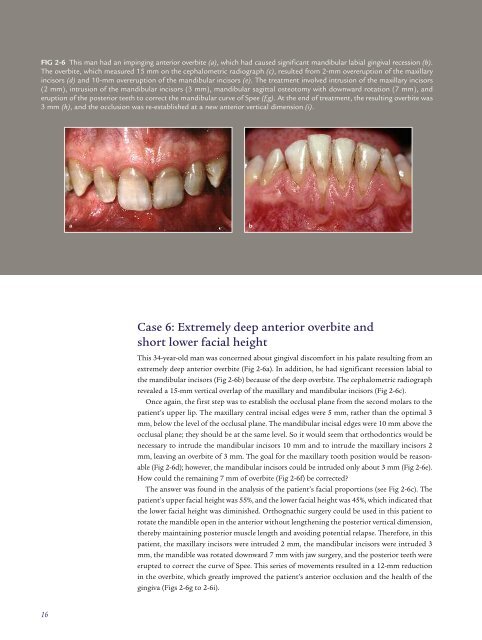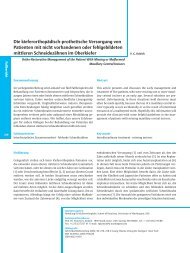altering vertical dimension in the perio-restorative patient - Kokich ...
altering vertical dimension in the perio-restorative patient - Kokich ...
altering vertical dimension in the perio-restorative patient - Kokich ...
Create successful ePaper yourself
Turn your PDF publications into a flip-book with our unique Google optimized e-Paper software.
FIG 2-6 This man had an imp<strong>in</strong>g<strong>in</strong>g anterior overbite (a), which had caused significant mandibular labial g<strong>in</strong>gival recession (b).<br />
The overbite, which measured 15 mm on <strong>the</strong> cephalometric radiograph (c), resulted from 2-mm overeruption of <strong>the</strong> maxillary<br />
<strong>in</strong>cisors (d) and 10-mm overeruption of <strong>the</strong> mandibular <strong>in</strong>cisors (e). The treatment <strong>in</strong>volved <strong>in</strong>trusion of <strong>the</strong> maxillary <strong>in</strong>cisors<br />
(2 mm), <strong>in</strong>trusion of <strong>the</strong> mandibular <strong>in</strong>cisors (3 mm), mandibular sagittal osteotomy with downward rotation (7 mm), and<br />
eruption of <strong>the</strong> posterior teeth to correct <strong>the</strong> mandibular curve of Spee (f,g). At <strong>the</strong> end of treatment, <strong>the</strong> result<strong>in</strong>g overbite was<br />
3 mm (h), and <strong>the</strong> occlusion was re-established at a new anterior <strong>vertical</strong> <strong>dimension</strong> (i).<br />
a<br />
b<br />
Case 6: Extremely deep anterior overbite and<br />
short lower facial height<br />
This 34-year-old man was concerned about g<strong>in</strong>gival discomfort <strong>in</strong> his palate result<strong>in</strong>g from an<br />
extremely deep anterior overbite (Fig 2-6a). In addition, he had significant recession labial to<br />
<strong>the</strong> mandibular <strong>in</strong>cisors (Fig 2-6b) because of <strong>the</strong> deep overbite. The cephalometric radiograph<br />
revealed a 15-mm <strong>vertical</strong> overlap of <strong>the</strong> maxillary and mandibular <strong>in</strong>cisors (Fig 2-6c).<br />
Once aga<strong>in</strong>, <strong>the</strong> first step was to establish <strong>the</strong> occlusal plane from <strong>the</strong> second molars to <strong>the</strong><br />
<strong>patient</strong>’s upper lip. The maxillary central <strong>in</strong>cisal edges were 5 mm, ra<strong>the</strong>r than <strong>the</strong> optimal 3<br />
mm, below <strong>the</strong> level of <strong>the</strong> occlusal plane. The mandibular <strong>in</strong>cisal edges were 10 mm above <strong>the</strong><br />
occlusal plane; <strong>the</strong>y should be at <strong>the</strong> same level. So it would seem that orthodontics would be<br />
necessary to <strong>in</strong>trude <strong>the</strong> mandibular <strong>in</strong>cisors 10 mm and to <strong>in</strong>trude <strong>the</strong> maxillary <strong>in</strong>cisors 2<br />
mm, leav<strong>in</strong>g an overbite of 3 mm. The goal for <strong>the</strong> maxillary tooth position would be reasonable<br />
(Fig 2-6d); however, <strong>the</strong> mandibular <strong>in</strong>cisors could be <strong>in</strong>truded only about 3 mm (Fig 2-6e).<br />
How could <strong>the</strong> rema<strong>in</strong><strong>in</strong>g 7 mm of overbite (Fig 2-6f) be corrected?<br />
The answer was found <strong>in</strong> <strong>the</strong> analysis of <strong>the</strong> <strong>patient</strong>’s facial proportions (see Fig 2-6c). The<br />
<strong>patient</strong>’s upper facial height was 55%, and <strong>the</strong> lower facial height was 45%, which <strong>in</strong>dicated that<br />
<strong>the</strong> lower facial height was dim<strong>in</strong>ished. Orthognathic surgery could be used <strong>in</strong> this <strong>patient</strong> to<br />
rotate <strong>the</strong> mandible open <strong>in</strong> <strong>the</strong> anterior without leng<strong>the</strong>n<strong>in</strong>g <strong>the</strong> posterior <strong>vertical</strong> <strong>dimension</strong>,<br />
<strong>the</strong>reby ma<strong>in</strong>ta<strong>in</strong><strong>in</strong>g posterior muscle length and avoid<strong>in</strong>g potential relapse. Therefore, <strong>in</strong> this<br />
<strong>patient</strong>, <strong>the</strong> maxillary <strong>in</strong>cisors were <strong>in</strong>truded 2 mm, <strong>the</strong> mandibular <strong>in</strong>cisors were <strong>in</strong>truded 3<br />
mm, <strong>the</strong> mandible was rotated downward 7 mm with jaw surgery, and <strong>the</strong> posterior teeth were<br />
erupted to correct <strong>the</strong> curve of Spee. This series of movements resulted <strong>in</strong> a 12-mm reduction<br />
<strong>in</strong> <strong>the</strong> overbite, which greatly improved <strong>the</strong> <strong>patient</strong>’s anterior occlusion and <strong>the</strong> health of <strong>the</strong><br />
g<strong>in</strong>giva (Figs 2-6g to 2-6i).<br />
16





